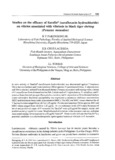Genomic analysis of Vibrio harveyi strain PH1009, a potential multi-drug resistant pathogen due to acquisition of toxin genes

Associated URL
www.cell.comDate
2023-03-25Author
Page views
734Metadata
Show full item recordCited times in Scopus
Share
Abstract
In has increasingly been observed that viral and bacterial coinfection frequently occurs among cultured shrimp and this coinfection could exacerbate the disease phenotype. Here, we describe a newly discovered bacterial strain, Vibrio harveyi PH1009 collected from Masbate Island, Philippines that was found to be co-infecting with the White Spot Syndrome virus a sample of black tiger prawn, Penaeus monodon. The genome of V. harveyi PH1009 was sequenced, assembled, and annotated. Average Nucleotide identity calculation with Vibrio harveyi strains confirmed its taxonomic identity. It is a potential multi-drug and multi-heavy metal resistant strain based on the multiple antibiotic and heavy metal resistance determinants annotated on its genome. Two prophage regions were identified in its genome. One contained genes for Zona occludens toxin (Zot) and Accessory cholera toxin (Ace), essential toxins of toxigenic V. cholerae strains apart from CTX toxins. Pan-genome analysis of V. harveyi strains, including PH1009, revealed an “open” pan-genome for V. harveyi and a core genome mainly composed of genes necessary for growth and metabolism. Phylogenetic tree based on the core genome alignment revealed that PH1009 was closest to strains QT520, CAIM 1754, and 823tez1. Published virulence factors present on the strain QT520 suggest similar pathogenicity with PH1009. However, PH1009 Zot was not found on related strains but was present in strains HENC-01 and CAIM 148. Most unique genes found in the PH1009 strain were identified as hypothetical proteins. Further annotation showed that several of these hypothetical proteins were phage transposases, integrases, and transcription regulators, implying the role of bacteriophages in the distinct genomic features of the PH1009 genome. The PH1009 genome will serve as a valuable genomic resource for comparative genomic studies and in understanding the disease mechanism of the Vibrio harveyi species.
Description
The following is the Supplementary data to this article: Download .xls (8.95 MB)
Suggested Citation
De Mesa, C. A., Mendoza, R., Penir, S. M., dela Pena, L. D., Amar, E., & Saloma, C. (2023). Genomic analysis of Vibrio harveyi strain PH1009, a potential multi-drug resistant pathogen due to acquisition of toxin genes. Heliyon , 9(4), e14926. https://doi.org/10.1016/j.heliyon.2023.e14926
Subject
Taxonomic term
Collections
- AQD Journal Articles [1249]
Related items
Showing items related by title, author, creator and subject.
-
Growth, plasma cortisol, liver and kidney histology, and resistance to vibriosis in brown-marbled grouper, Epinephelus fuscoguttatus fed onion and ginger
Apines-Amar, Mary Jane S.; Amar, Edgar C.; Faisan, Joseph P., Jr. (Bioflux, 2013)The health-promoting effects of dietary onion and ginger were studied in brown marbled grouper, Epinephelus fuscoguttatus. An eight-week feeding trial was conducted to evaluate the effects of dietary onion and ginger on ... -
Studies on the efficacy of Sarafin® (sarafloxacin hydrochloride) on vibrios associated with vibriosis in black tiger shrimp (Penaeus monodon)
Pakingking, Rolando V., Jr.; Lacierda, Erlinda; Torres, James L. (Fish Health Section, Asian Fisheries Society, 2002)In vitro activity of Sarafin® (sarafloxacin hydrochloride) was determined against 7 luminous Vibrio harveyi isolates and 3 non-luminous Vibrio species (V. parahaemolyticus, V. alginolyticus and Vibrio species) isolated ... -
Occurrence of Vibrio sp. infection in grouper, Epinephelus suillus
Lavilla-Pitogo, Celia R.; Castillo, A. R.; de la Cruz, Margarita C. (Blackwell Publishing, 1992)Vibrio sp., was consistently isolated from grouper, Epinephelus suillus, with bacterial infection. Fingerlings, which were challenged with the bacterium by injection, were highly susceptible. Immersion challenge resulted ...



